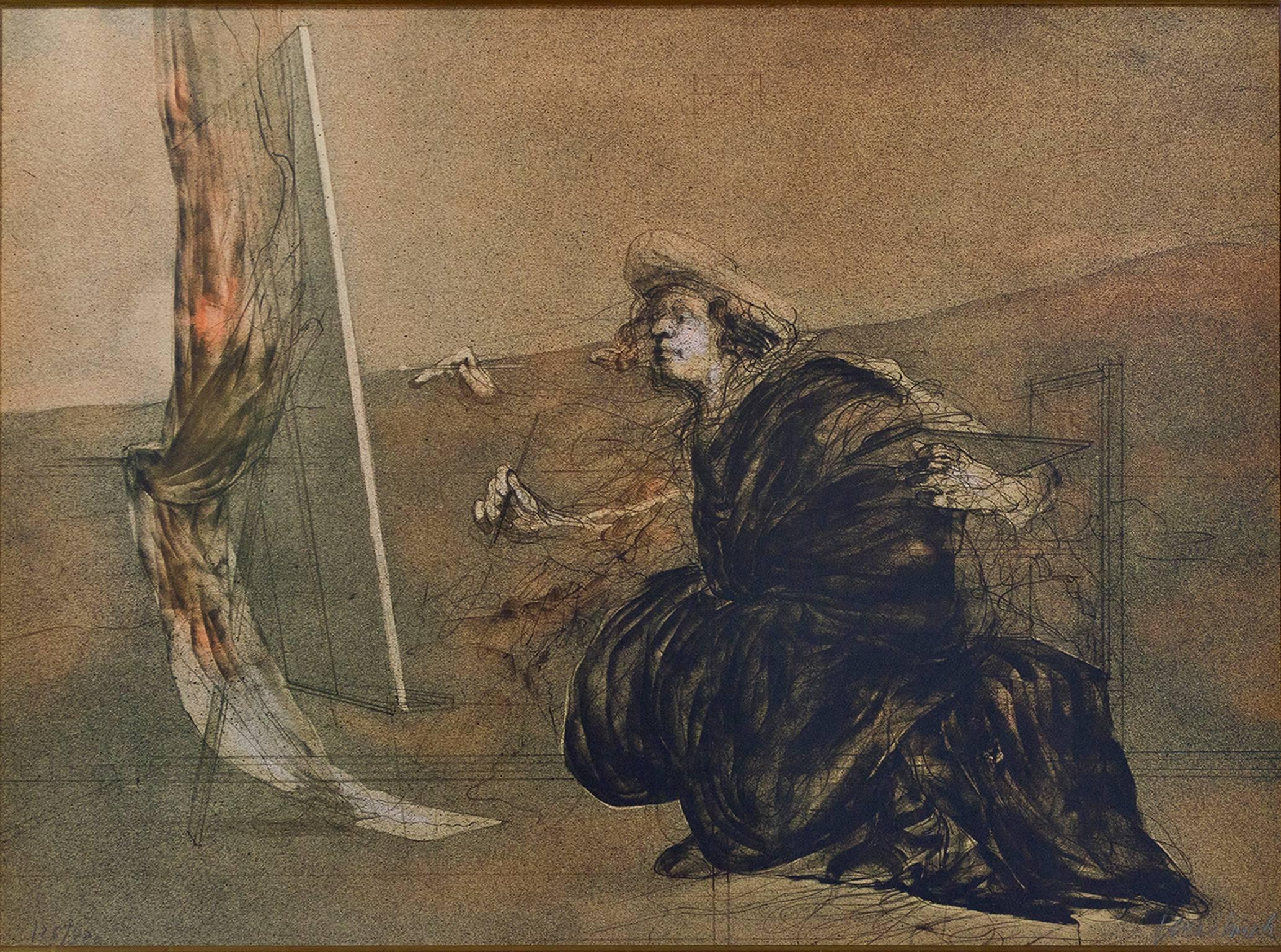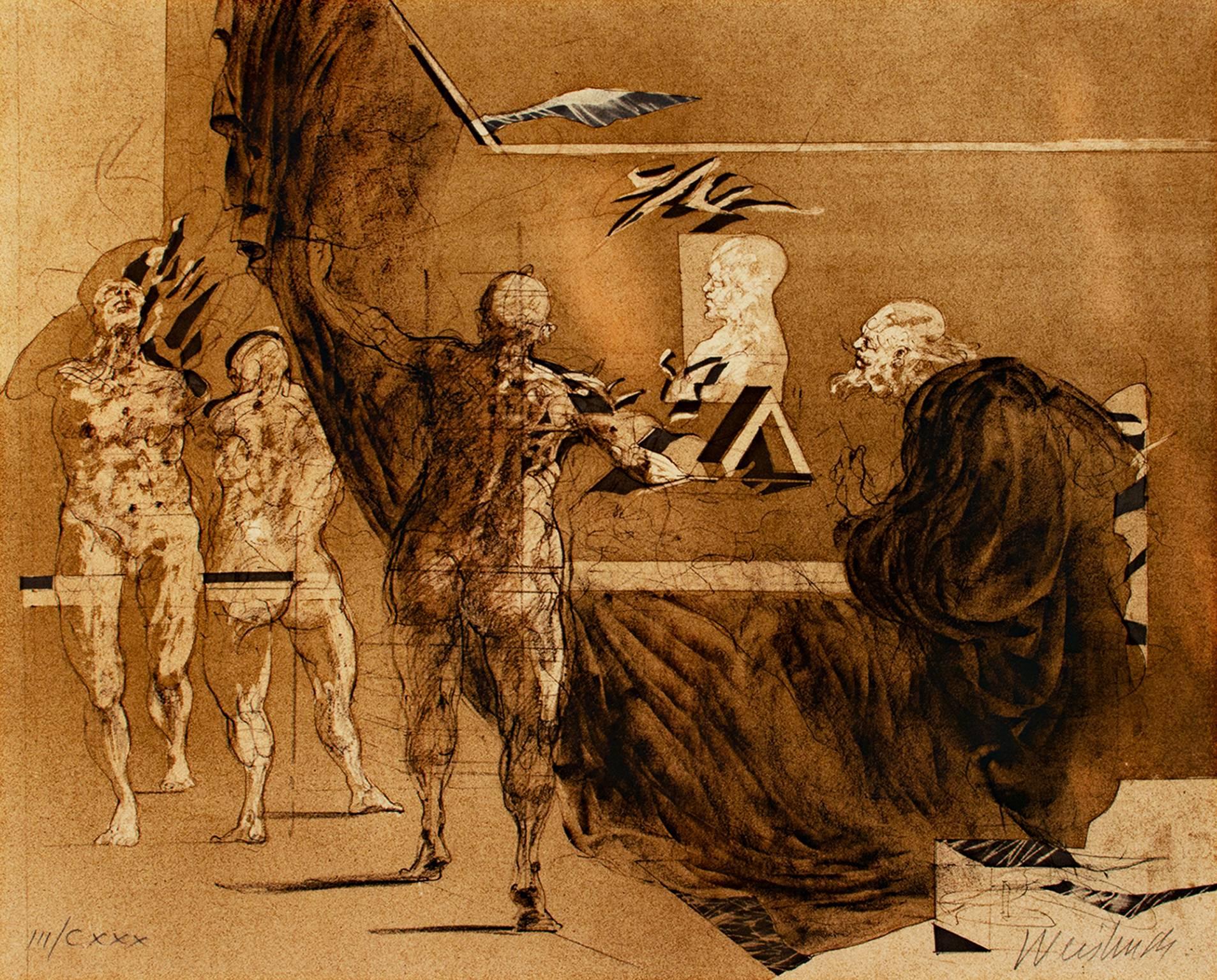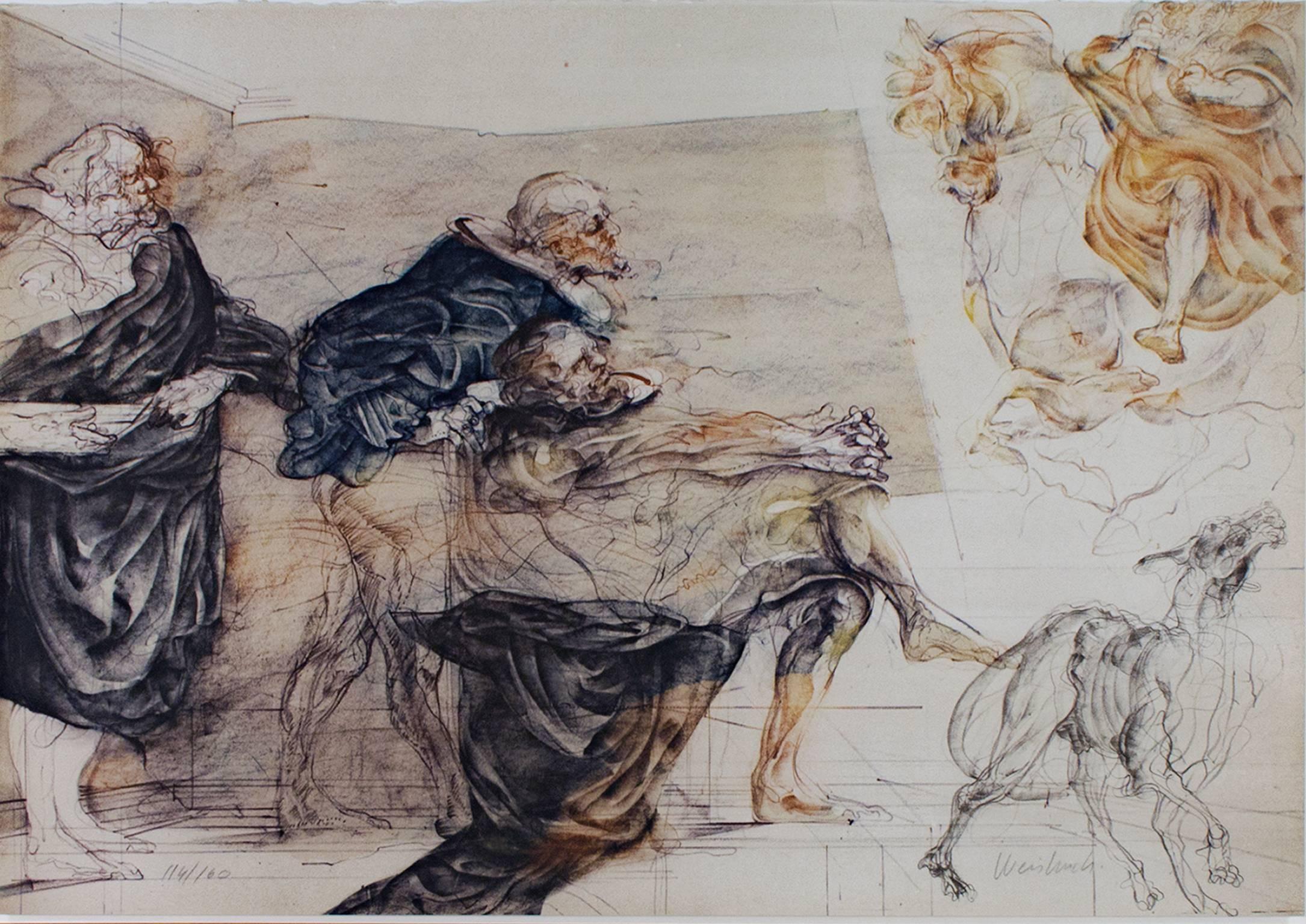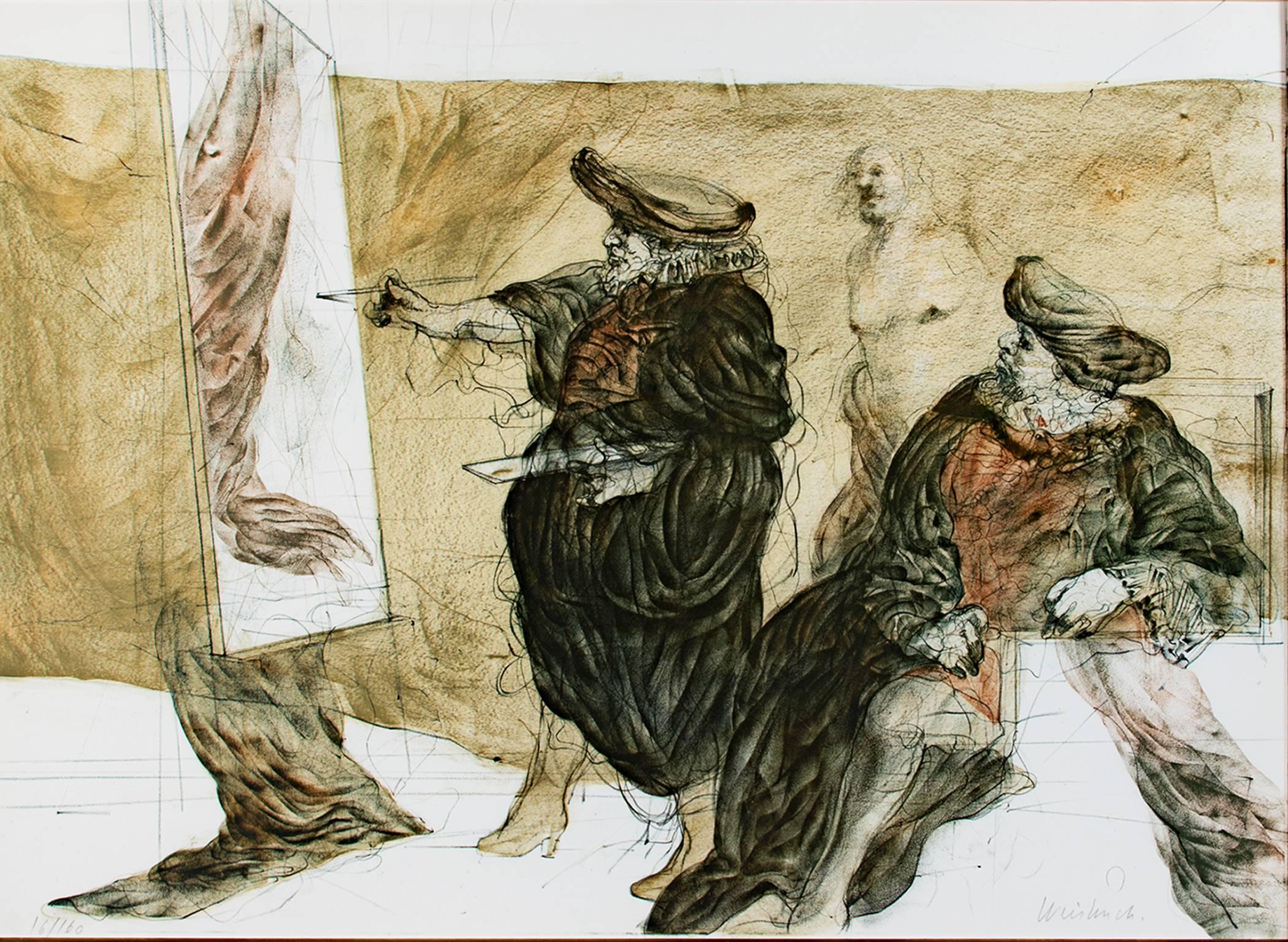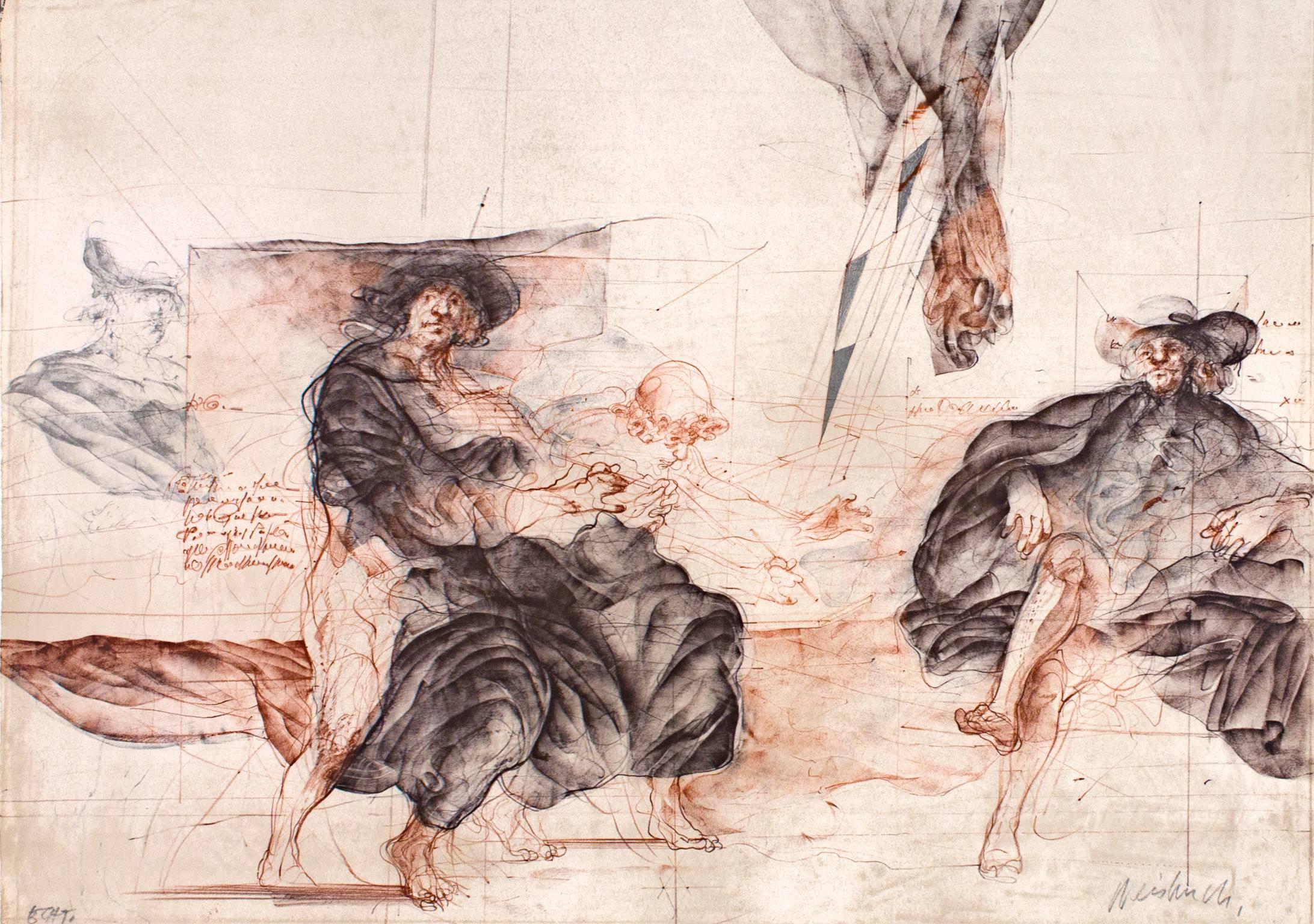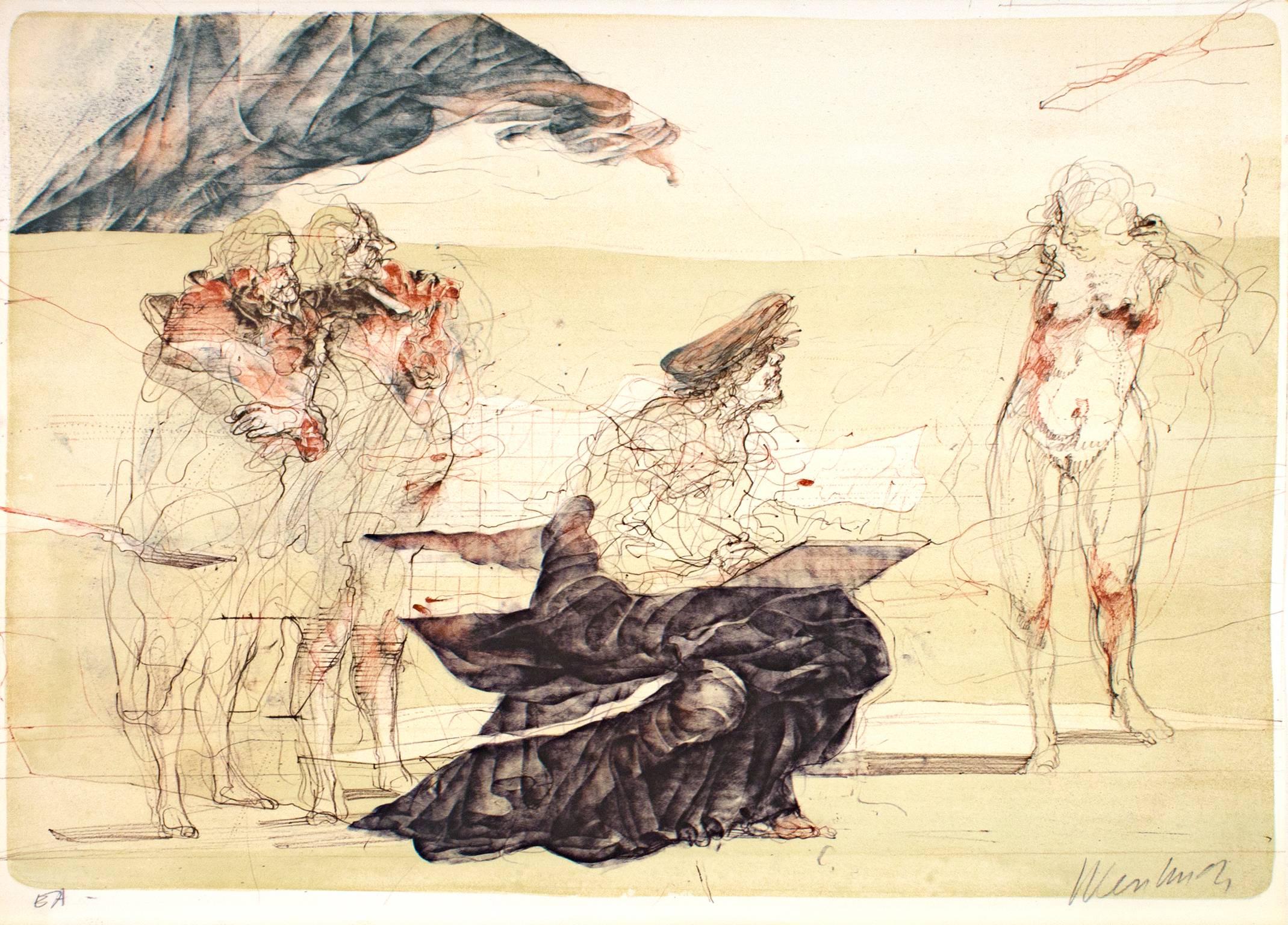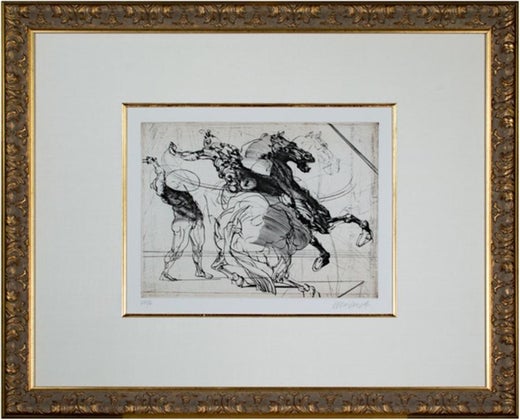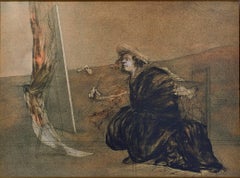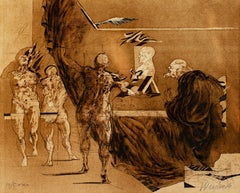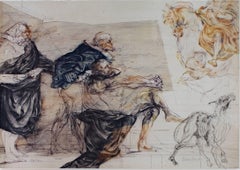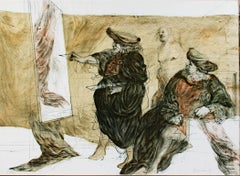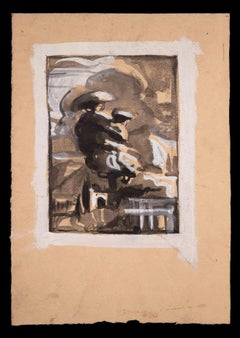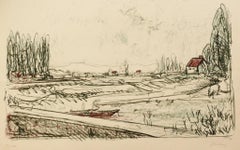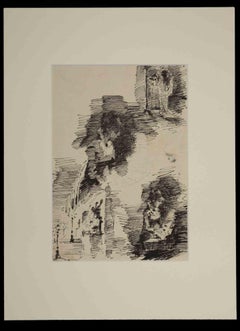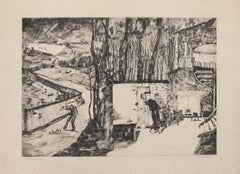Items Similar to 20th century color lithograph figurative landscape print sepia sketch signed
Want more images or videos?
Request additional images or videos from the seller
1 of 10
Claude Weisbuch20th century color lithograph figurative landscape print sepia sketch signed1976
1976
$5,220
£3,951.32
€4,532.18
CA$7,337.29
A$8,074.61
CHF 4,234.23
MX$97,992.92
NOK 52,927.20
SEK 50,107.40
DKK 33,834.96
About the Item
"Nicolas Poussin, Homage" is an original color lithograph by Claude Weisbuch. The artist signed the piece in the lower right and wrote the edition number, 37/180, in the lower left. This piece depicts three figures in the center of the space. Weisbuch's inspiration for this piece and his reference for the figures is Nicholas Poussin's "Et in Arcadia Ego".
21 1/2" x 29 7/8" art
27 1/2" x 29 7/8" frame
Claude Weisbuch was born on February 8th, 1927 in Thionville, France. His art includes drawing, painting and lithographs. Inventive and unique with his style he uses color range that is warm and rich in tone, certainly equal to that of Rembrandt. The fluidity of line and creation of motion is even more vigorous that in the work of Daumier or Toulouse Lautrec. His creativeness in composition is awesome and seems to have infinite possibilities of variation and vision. Weisbuch died in 2014.
Exhibitions
Herve Odermatt Gallery Paris, France
Escole de Paris Paris, France
David Barnett Gallery Milwaukee,Wisconsin
Education
Ecole des Beaux-Arts de Nancy Nancy, France
- Creator:Claude Weisbuch (1927, French)
- Creation Year:1976
- Dimensions:Height: 27.5 in (69.85 cm)Width: 35.25 in (89.54 cm)
- Medium:
- Movement & Style:
- Period:
- Condition:
- Gallery Location:Milwaukee, WI
- Reference Number:Seller: 5913g1stDibs: LU60532248573
Claude Weisbuch
Claude Weisbuch was born in Thionville, France in 1927 and was a pupil at L' École des Beaux-Arts de Nancy, France. As a painter, engraver, and exceptional lithographer, Claude Weisbuch has painted active motifs, such as musicians, horses, and characters. Dominating in his work, by the relief and the velvety line which characterizes drypoint, his etchings are the strongest representations of his figures, intensely lively after the 1960s. Using dark tones which express his sharp sense, Claude Weisbuch ceaselessly captures life's dynamics, as the pictorial, musical and literary expressions that are essentially human. Whether it is the impassioned violinist, the mercurial actor, or the sitter shrouded with silent intensity, they have all been rendered with Weisbuch's love for drama. The brushstrokes are sweeping and bold while the paint is fluid. His pictures, full of movement, give one the impression of time-lapsed motion and display an expression of passionate humanity tinged with a unique energy. Weisbuch has been quoted as saying “I like the sketch, the uncompleted, the painting filled with mystery,”. "Some important things to look for in evaluating an artist for such a position of honour are: an inventiveness of style, a prolific output, and a consistency of quality--Claude Weisbuch has all three. His style is unique with a color range that is rich and warm in tone, certainly equal to that of Rembrandt. The fluidity of line and creation of motion is even more vigorous than in the work of Daumier or Toulouse Lautrec. His creativeness in composition is awesome and seems to have infinite possibilities of variation and vision." - David Barnett
About the Seller
4.9
Platinum Seller
Premium sellers with a 4.7+ rating and 24-hour response times
Established in 1966
1stDibs seller since 2017
447 sales on 1stDibs
Typical response time: 3 hours
- ShippingRetrieving quote...Shipping from: Milwaukee, WI
- Return Policy
Authenticity Guarantee
In the unlikely event there’s an issue with an item’s authenticity, contact us within 1 year for a full refund. DetailsMoney-Back Guarantee
If your item is not as described, is damaged in transit, or does not arrive, contact us within 7 days for a full refund. Details24-Hour Cancellation
You have a 24-hour grace period in which to reconsider your purchase, with no questions asked.Vetted Professional Sellers
Our world-class sellers must adhere to strict standards for service and quality, maintaining the integrity of our listings.Price-Match Guarantee
If you find that a seller listed the same item for a lower price elsewhere, we’ll match it.Trusted Global Delivery
Our best-in-class carrier network provides specialized shipping options worldwide, including custom delivery.More From This Seller
View All20th century color lithograph figurative print artist easel canvas scene signed
By Claude Weisbuch
Located in Milwaukee, WI
"Artiste Dans l'Atelier" is an original lithograph by Claude Weisbuch. The artist signed the piece lower right and wrote the edition number (126/320) in the lower left. This piece de...
Category
1970s Modern Figurative Prints
Materials
Lithograph
20th century color lithograph figurative surrealist print sepia sketch signed
By Claude Weisbuch
Located in Milwaukee, WI
"Le Trait de la Figure" is an original lithograph by Claude Weisbuch. The artist signed the piece lower right and wrote the edition number (III/CXX) in the lower left. This piece dep...
Category
1970s Modern Figurative Prints
Materials
Lithograph
20th century color lithograph figurative print male subjects sketch scene signed
By Claude Weisbuch
Located in Milwaukee, WI
"Le Portrait Equestre" is an original color lithograph by Claude Weisbuch. This piece depicts a number of figures in black robes looking at horses. The a...
Category
1970s Modern Figurative Prints
Materials
Lithograph
20th century color lithograph figurative print male subjects sketch scene signed
By Claude Weisbuch
Located in Milwaukee, WI
"Geste et Peinture" is an original color lithograph by Claude Weisbuch. The artist signed the piece in the lower right and wrote the edition number (16/160) in the lower left. This p...
Category
1970s Modern Figurative Prints
Materials
Lithograph
20th century color lithograph figurative print male subjects sketch scene signed
By Claude Weisbuch
Located in Milwaukee, WI
"La Lecon Du Professor Tulp" is an original lithograph by Claude Weisbuch. The artist signed the piece lower right and wrote the edition (ETAT) in the lower left. This piece depicts ...
Category
1970s Modern Figurative Prints
Materials
Lithograph, Paper
"La Visite des Amateurs, " Original Color figurative sketch print signed
By Claude Weisbuch
Located in Milwaukee, WI
"La Visite des Amateurs" is an original color lithograph by Claude Weisbuch. It is signed in the lower right and editioned "EA" in the lower left. This piece depicts four figures: one artist in black robes, two onlookers, and one female nude model. They appear to be in an endless flat landscape.
22" x 29 7/8" art
Claude Weisbuch was born on February 8th, 1927 in Thionville, France. His art includes drawing, painting and lithographs. Inventive and unique with his style he uses color range that is warm and rich in tone, certainly equal to that of Rembrandt. The fluidity of line and creation of motion is even more vigorous that in the work of Daumier or Toulouse Lautrec. His creativeness in composition is awesome and seems to have infinite possibilities of variation and vision. Weisbuch died in 2014.
Exhibitions
Herve Odermatt Gallery Paris, France
Escole de Paris Paris, France
David Barnett...
Category
1970s Figurative Prints
Materials
Lithograph
You May Also Like
Composition - Original Painting by Claude Guez - Mid-20th Century
By Claude Guez
Located in Roma, IT
Composition is an Original Tempera realized by Claude Guez in the early 20th century.
The artwork is in good condition on a yellowed cardboard.
No signa...
Category
Mid-20th Century Modern Figurative Drawings and Watercolors
Materials
Tempera
Landscape - Lithograph by Giuseppe Zancan - Late 20th Century
By Giuseppe Zancan
Located in Roma, IT
Landscape is a beautiful lithograph realized by the Italian artist Giuseppe Zancan (Turin, January 14, 1936 - Turin, June 8, 2016).
Hand-signed in pencil on the lower right margin and signed on plate.
Numbered on the lower right in pencil, copy 72 from an edition of 100 prints.
Good conditions.
This contemporary artwork represents a poetical landscape created through quick and confident short strokes, in well-balanced composition.
Giuseppe Zancan (Turin, January 14, 1936 - Turin, June 8, 2016), was an Italian journalist and artist, His first personal exhibition of engravings dates from this period, in 1967, ordered at the L’Arte Antica gallery in Turin. These were engravings closely related to the work of Beppi Zancan's ideal teacher, Rembradt. In 1971 he exhibited again at the Ancient Art of Turin and at the Cabinet of Prints in Milan and in 1974 at the Casino of Sanremo. In 1974, he became a professional journalist and, in 1975, he was entrusted with the direction of Il Mago, one of the most important Italian comic...
Category
Late 20th Century Contemporary Figurative Prints
Materials
Lithograph
Landscape - Original Drawing - Mid 20th Century
Located in Roma, IT
Composition is an original drawing in pen realized in the mid-20th Century by an anonymous Artist.
Good Conditions.
The artwork is depicted through soft strokes in a well-balanced ...
Category
Mid-20th Century Modern Figurative Drawings and Watercolors
Materials
Pen
Landscape - Original Etching on Paper by David Rouviere - Mid-20th Century
Located in Roma, IT
Landscape is a beautiful original etching on paper realized by David Rouviere.
Signed on the lower left
Good conditions
This contemporary artwork represents a poetical landscape c...
Category
Mid-20th Century Figurative Prints
Materials
Etching
Landscape - Original Mixed Media - Mid 20th Century
Located in Roma, IT
Landscape is an original artwork in mixed media (ink, watercolor and white lead) on paper realized by an Anonymous artist of XX century.
The condition of the artwork shows the trace...
Category
Mid-20th Century Figurative Prints
Materials
Ink, Watercolor
Landscape - Etching by Arnoldo Ciarrocchi - Mid-20th Century
By Arnoldo Ciarrocchi
Located in Roma, IT
Landscape is a modern artwork realized by Arnoldo Ciarrocchi in the mid-20th Century.
Black and white etching.
Includes frame
Hand signed and dated on the lower margin. Edition of...
Category
1970s Modern Figurative Prints
Materials
Etching
More Ways To Browse
Vintage Arcadia
Mr Brainwash Happy Birthday
Mucha Hamlet
Mucha Salon Des Cent
Murakami Champagne Supernova
Oldrich Kulhanek
Otto Kuhler On Sale
Pablo Picasso Etching 1966
Pablo Picasso La Ronde De La Jeunesse
Pablo Picasso Serie
Pablo Picasso Serigraph
Pamela Bianco
Paolo Toschi
Paris Street Scene Lithograph
Paul Stewart
Pe Felix
Peter Mats
Peter Max 1971
